Abstract
The mediator(s) responsible for localized enhanced vascular permeability that characterizes an exacerbation of hereditary angioneurotic oedema (HAE) is thought to be a product of either contact or complement system activation. In contrast to normal individuals, plasma from these patients generates both kinin and vascular permeability-enhancing activity following incubation at 37 degrees C. Depletion of C1 inhibitor in both normal and C2-deficient plasma, but not in contact factor-deficient plasmas, resulted in generation of these activities. The kinin activity from incubated HAE plasma was susceptible to kininase inactivation and was blocked by a Bk2 receptor antagonist. Furthermore, this activity was isolated from HAE plasma; amino acid sequence analysis proved it to be bradykinin. Similarly, the vasopermeability-enhancing activity from ethanol-fractionated or boiled HAE plasma, collected during either attack or remission, co-eluted with bradykinin on reverse-phase high performance liquid chromatography (HPLC). These studies conclusively demonstrate that bradykinin is the major kinin and mediator of enhanced vascular permeability generated during incubation of HAE plasma. The role of other bioactive products, such as the C2 kinin, at local sites of oedema formation remains to be further defined.
Full text
PDF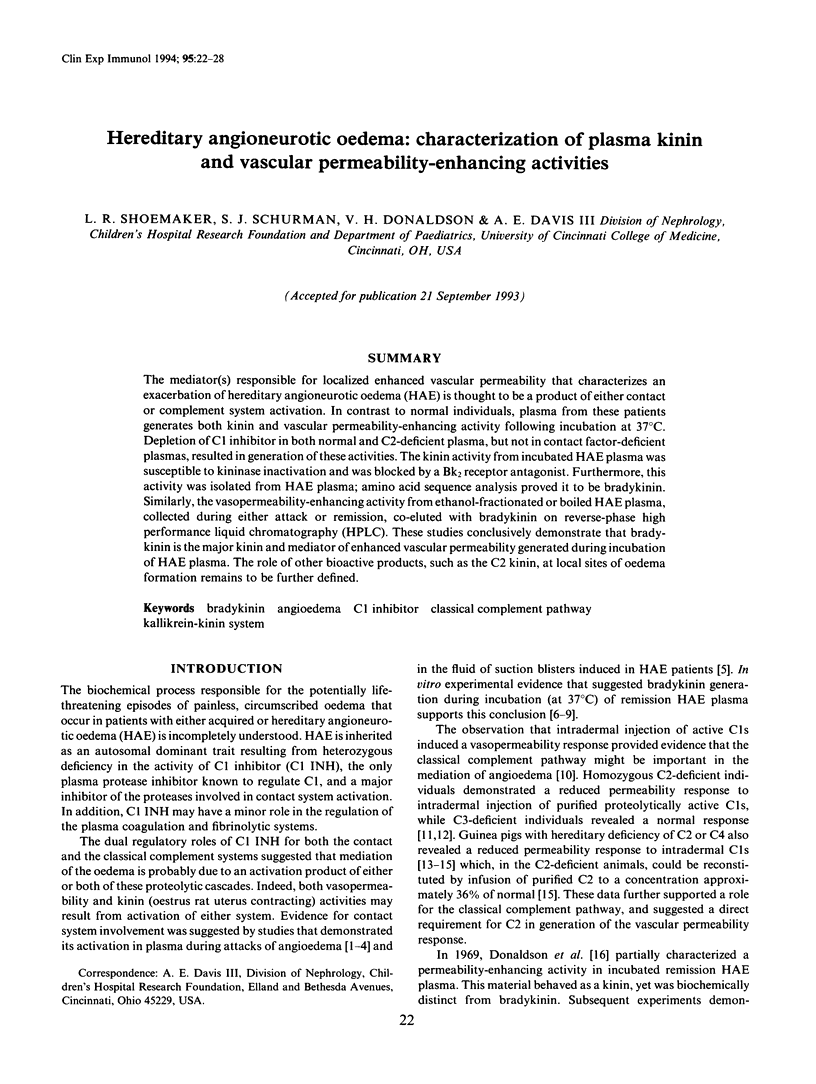
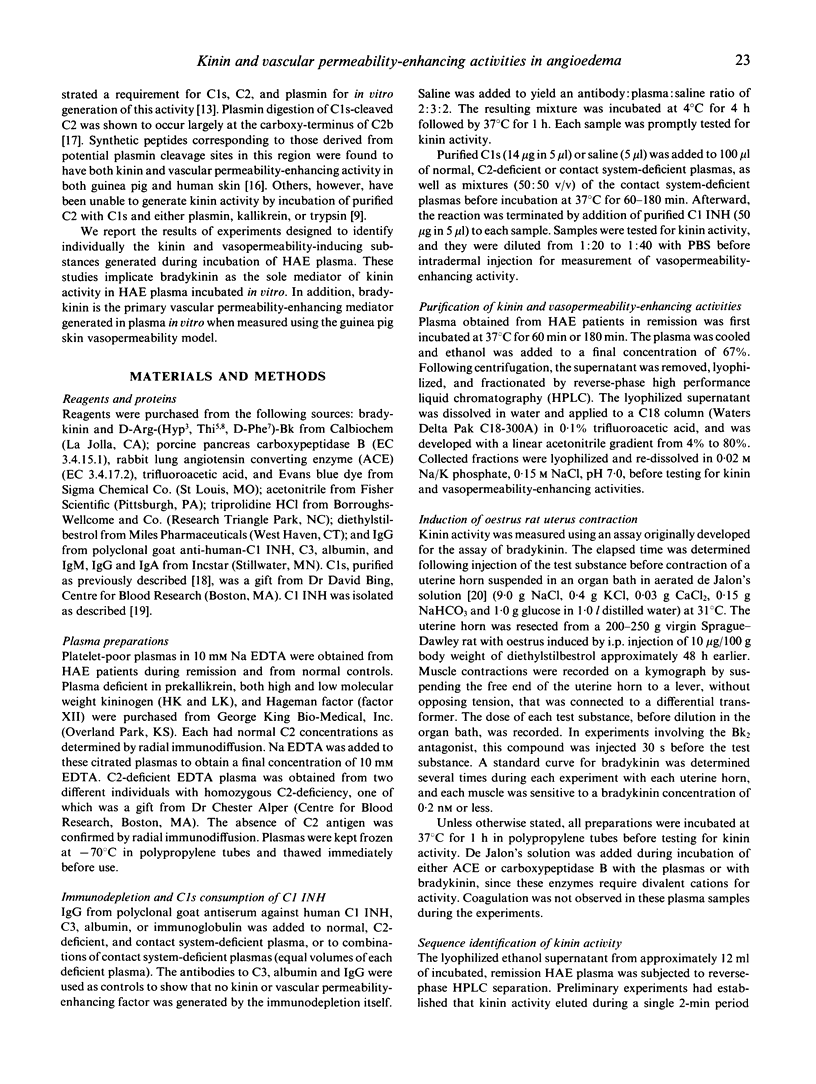
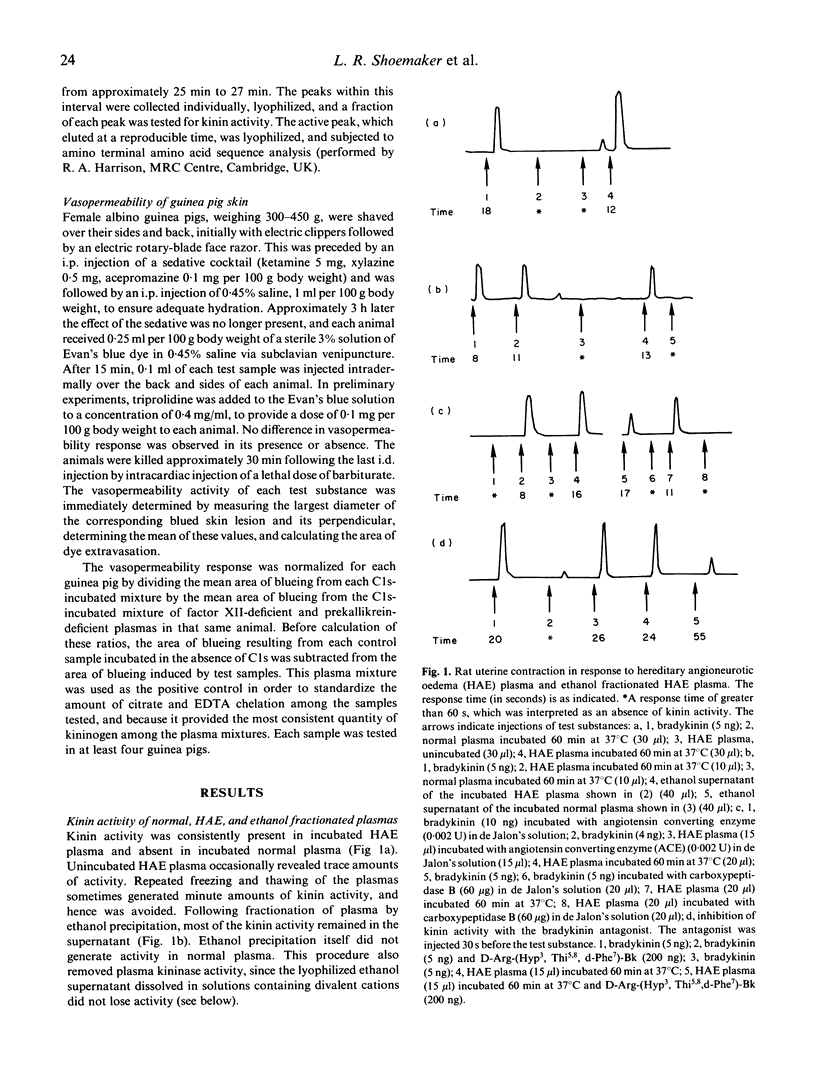
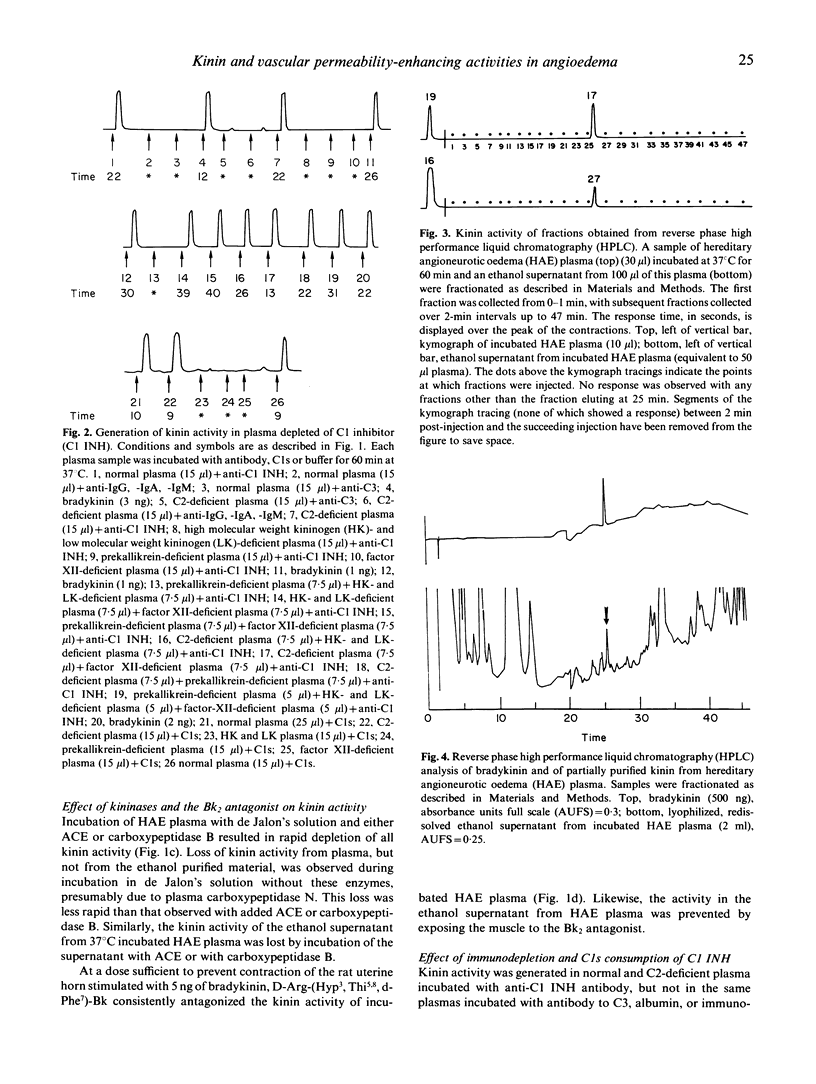
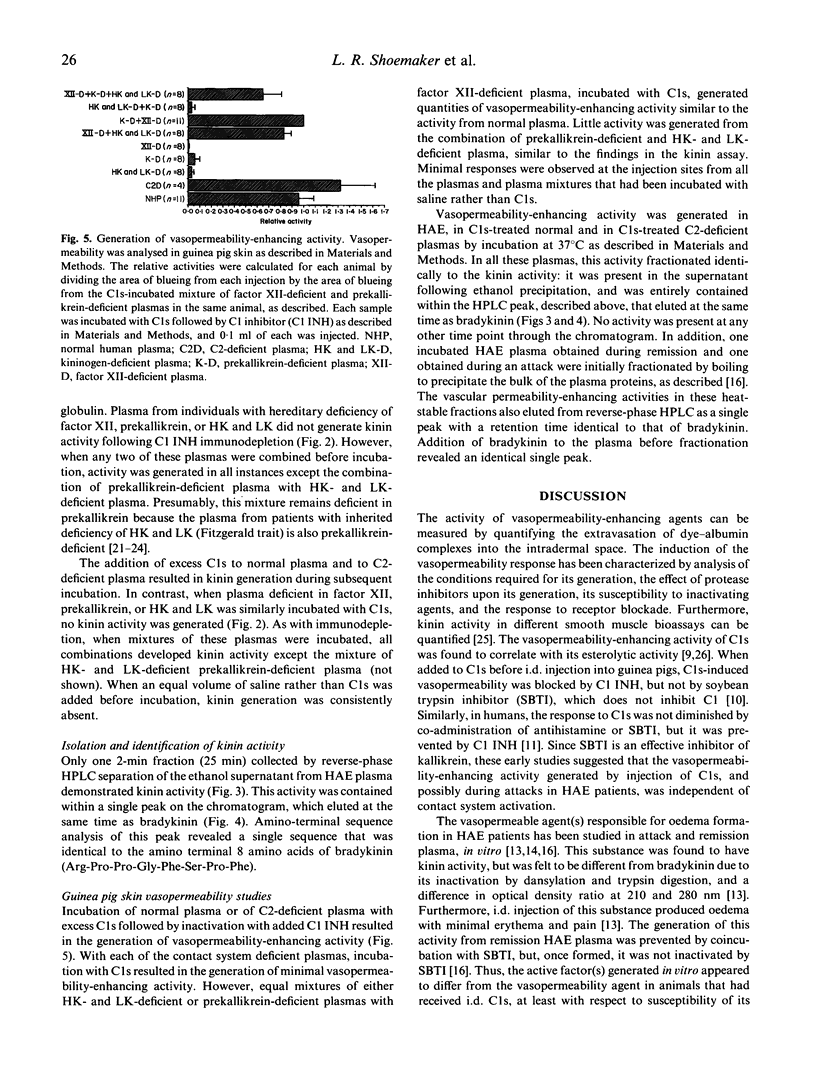
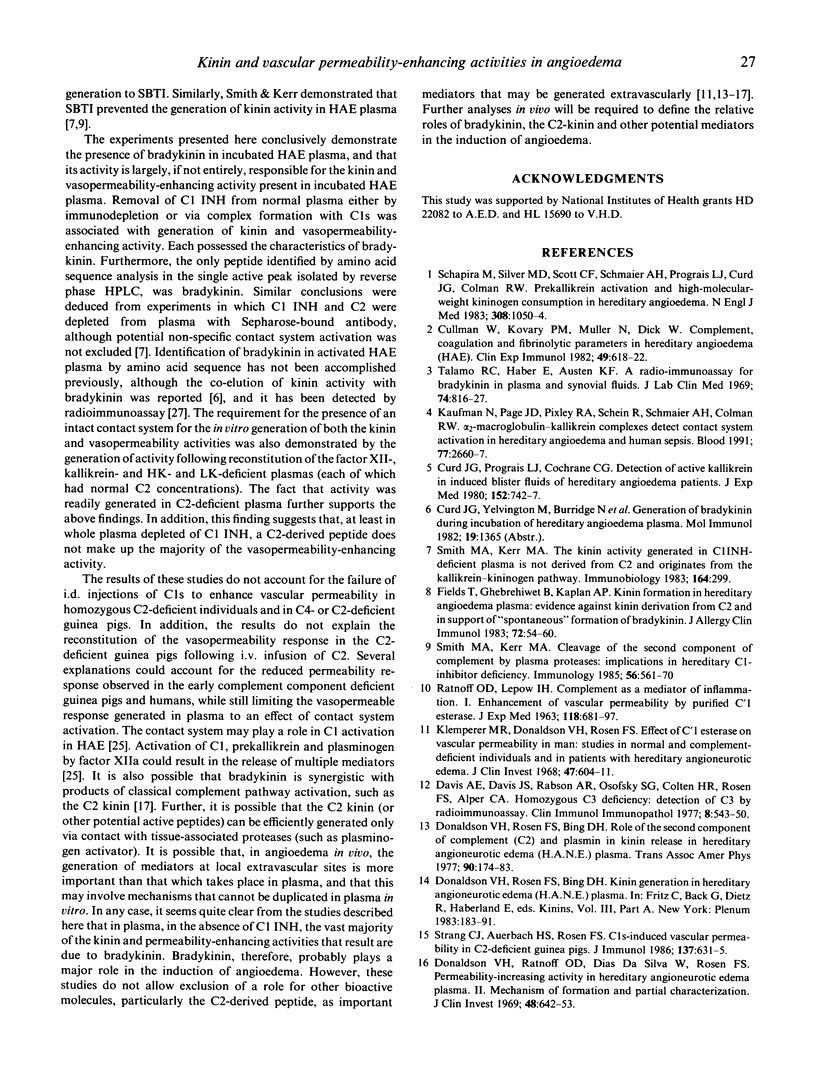
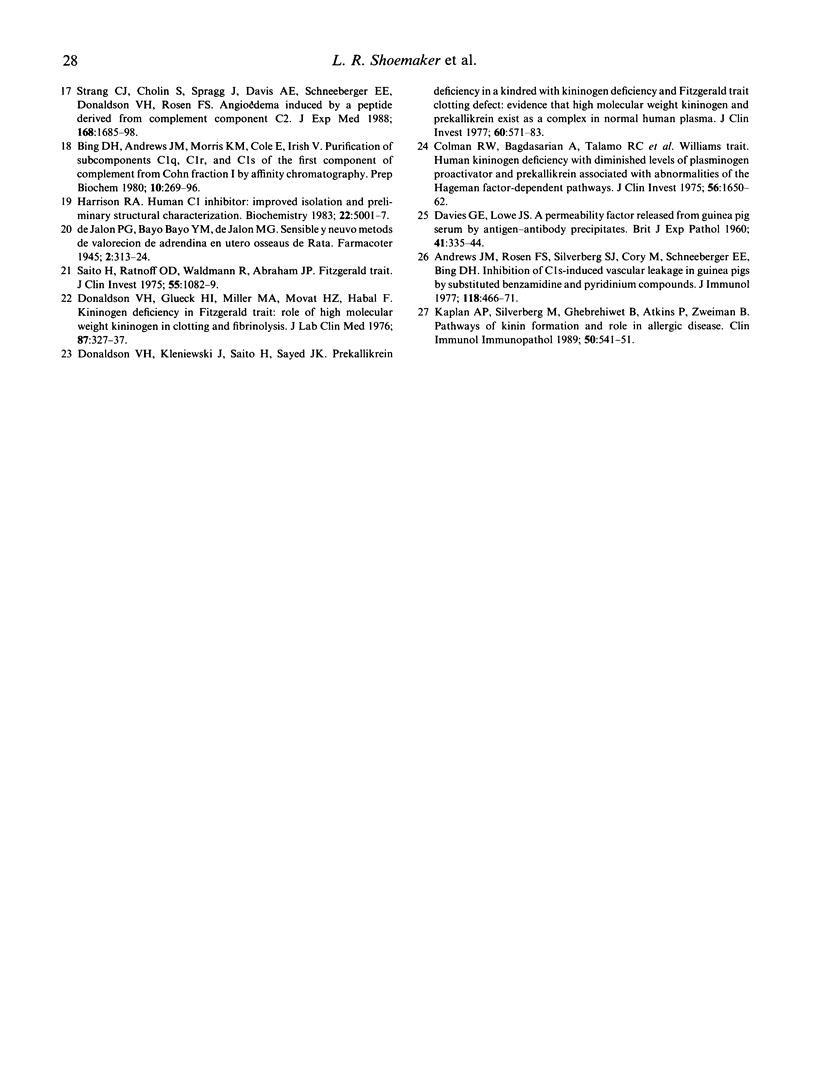
Selected References
These references are in PubMed. This may not be the complete list of references from this article.
- Andrews J. M., Rosen F. S., Silverberg S. J., Cory M., Schneeberger E. E., Bing D. H. Inhibition of C1s-induced vascular leakage in guinea pigs by substituted benzamidine and pyridinium compounds. J Immunol. 1977 Feb;118(2):466–471. [PubMed] [Google Scholar]
- Bing D. H., Andrews J. M., Morris K. M., Cole E., Irish V. Purification of subcomponents Clq, Cl(-)r and Cl(-)s of the first component of complement from Cohn Fraction I by affinity chromatography. Prep Biochem. 1980;10(3):269–296. doi: 10.1080/10826068009412829. [DOI] [PubMed] [Google Scholar]
- Colman R. W., Bagdasarian A., Talamo R. C., Scott C. F., Seavey M., Guimaraes J. A., Pierce J. V., Kaplan A. P. Williams trait. Human kininogen deficiency with diminished levels of plasminogen proactivator and prekallikrein associated with abnormalities of the Hageman factor-dependent pathways. J Clin Invest. 1975 Dec;56(6):1650–1662. doi: 10.1172/JCI108247. [DOI] [PMC free article] [PubMed] [Google Scholar]
- Cullmann W., Kövary P. M., Müller N., Dick W. Complement, coagulation and fibrinolytic parameters in hereditary angioedema (HAE). Clin Exp Immunol. 1982 Sep;49(3):618–622. [PMC free article] [PubMed] [Google Scholar]
- Curd J. G., Prograis L. J., Jr, Cochrane C. G. Detection of active kallikrein in induced blister fluids of hereditary angioedema patients. J Exp Med. 1980 Sep 1;152(3):742–747. doi: 10.1084/jem.152.3.742. [DOI] [PMC free article] [PubMed] [Google Scholar]
- DAVIES G. E., LOWE J. S. A permeability factor released from guinea-pig serum by antigen-antibody precipitates. Br J Exp Pathol. 1960 Aug;41:335–344. [PMC free article] [PubMed] [Google Scholar]
- Davis A. E., 3rd, Davis J. S., 4th, Rabson A. R., Osofsky S. G., Colten H. R., Rosen F. S., Alper C. A. Homozygous C3 deficiency: detection of C3 by radioimmunoassay. Clin Immunol Immunopathol. 1977 Nov;8(3):543–550. doi: 10.1016/0090-1229(77)90019-8. [DOI] [PubMed] [Google Scholar]
- Donaldson V. H., Glueck H. I., Miller M. A., Movat H. Z., Habal F. Kininogen deficiency in Fitzgerald trait: role of high molecular weight kininogen in clotting and fibrinolysis. J Lab Clin Med. 1976 Feb;87(2):327–337. [PubMed] [Google Scholar]
- Donaldson V. H., Kleniewski J., Saito H., Sayed J. K. Prekallikrein deficiency in a kindred with kininogen deficiency and Fitzgerald trait clotting defect. Evidence that high molecular weight kininogen and prekallikrein exist as a complex in normal human plasma. J Clin Invest. 1977 Sep;60(3):571–583. doi: 10.1172/JCI108809. [DOI] [PMC free article] [PubMed] [Google Scholar]
- Donaldson V. H., Ratnoff O. D., Dias Da Silva W., Rosen F. S. Permeability-increasing activity in hereditary angioneurotic edema plasma. II. Mechanism of formation and partial characterization. J Clin Invest. 1969 Apr;48(4):642–653. doi: 10.1172/JCI106022. [DOI] [PMC free article] [PubMed] [Google Scholar]
- Donaldson V. H., Rosen F. S., Bing D. H. Kinin generation in hereditary angioneurotic edema (H.A.N.E.) plasma. Adv Exp Med Biol. 1983;156:183–191. [PubMed] [Google Scholar]
- Donaldson V. H., Rosen F. S., Bing D. H. Role of the second component of complement (C2) and plasmin in kinin release in hereditary angioneurotic edema (H.A.N.E.) plasma. Trans Assoc Am Physicians. 1977;90:174–183. [PubMed] [Google Scholar]
- Fields T., Ghebrehiwet B., Kaplan A. P. Kinin formation in hereditary angioedema plasma: evidence against kinin derivation from C2 and in support of "spontaneous" formation of bradykinin. J Allergy Clin Immunol. 1983 Jul;72(1):54–60. doi: 10.1016/0091-6749(83)90052-0. [DOI] [PubMed] [Google Scholar]
- Harrison R. A. Human C1 inhibitor: improved isolation and preliminary structural characterization. Biochemistry. 1983 Oct 11;22(21):5001–5007. doi: 10.1021/bi00290a019. [DOI] [PubMed] [Google Scholar]
- Kaufman N., Page J. D., Pixley R. A., Schein R., Schmaier A. H., Colman R. W. Alpha 2-macroglobulin-kallikrein complexes detect contact system activation in hereditary angioedema and human sepsis. Blood. 1991 Jun 15;77(12):2660–2667. [PubMed] [Google Scholar]
- Klemperer M. R., Donaldson V. H., Rosen F. S. Effect of C'1 esterase on vascular permeability in man: studies in normal and complement-deficient individuals and in patients with hereditary angioneurotic edema. J Clin Invest. 1968 Mar;47(3):604–611. doi: 10.1172/JCI105756. [DOI] [PMC free article] [PubMed] [Google Scholar]
- RATNOFF O. D., LEPOW I. H. COMPLEMENT AS A MEDIATOR OF INFLAMMATION. ENHANCEMENT OF VASCULAR PERMEABILITY BY PURIFIED HUMAN C'1 ESTERASE. J Exp Med. 1963 Nov 1;118:681–698. doi: 10.1084/jem.118.5.681. [DOI] [PMC free article] [PubMed] [Google Scholar]
- Saito H., Ratnoff O. D., Waldmann R., Abraham J. P. Fitzgerald Trait: Deficiency of a Hitherto Unrecognized Agent, Fitzgerald Factor, Participating in Surface-Mediated Reactions of Clotting, Fibrinolysis, Generation of Kinins, and the Property of Diluted Plasma Enhancing Vascular Permeability (PF/Dil). J Clin Invest. 1975 May;55(5):1082–1089. doi: 10.1172/JCI108009. [DOI] [PMC free article] [PubMed] [Google Scholar]
- Schapira M., Silver L. D., Scott C. F., Schmaier A. H., Prograis L. J., Jr, Curd J. G., Colman R. W. Prekallikrein activation and high-molecular-weight kininogen consumption in hereditary angioedema. N Engl J Med. 1983 May 5;308(18):1050–1053. doi: 10.1056/NEJM198305053081802. [DOI] [PubMed] [Google Scholar]
- Smith M. A., Kerr M. A. Cleavage of the second component of complement by plasma proteases: implications in hereditary C1-inhibitor deficiency. Immunology. 1985 Nov;56(3):561–570. [PMC free article] [PubMed] [Google Scholar]
- Strang C. J., Auerbach H. S., Rosen F. S. C1s-induced vascular permeability in C2-deficient guinea pigs. J Immunol. 1986 Jul 15;137(2):631–635. [PubMed] [Google Scholar]
- Strang C. J., Cholin S., Spragg J., Davis A. E., 3rd, Schneeberger E. E., Donaldson V. H., Rosen F. S. Angioedema induced by a peptide derived from complement component C2. J Exp Med. 1988 Nov 1;168(5):1685–1698. doi: 10.1084/jem.168.5.1685. [DOI] [PMC free article] [PubMed] [Google Scholar]
- Talamo R. C., Haber E., Austen K. F. A radioimmunoassay for bradykinin in plasma and synovial fluid. J Lab Clin Med. 1969 Nov;74(5):816–827. [PubMed] [Google Scholar]


